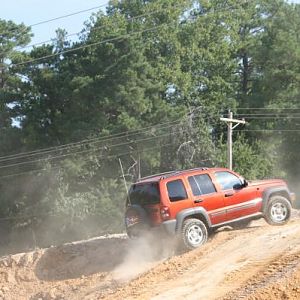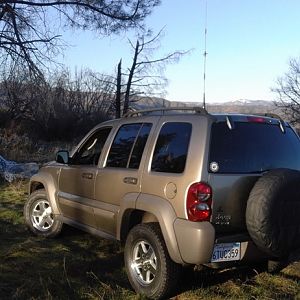I recently solved a rough engine performance problem by some spark plug trial and error. I had responded to someone else's post, then discovered an error I had made regarding diagnosis/recommendation, and did an edit/update to that response. What follows is taken from that correction, and may help others when doing a simple tune up.
Please note:
A. I have a new, remanufactured Tristar engine that works just fine, less that 3K miles on it while this T&E exercise is going on.
B. *All* sensors, cats, fuel filter, fuel pump, PCM, TCM, PCV, coils (and their wires/connectors), injectors (and their wires/connectors), (and plugs of course,) fuel rail, battery, alternator... are all brand new Mopar/Crown/NGK/Flagship1 parts.
C. Because I had a slammin' trans, the trans had a full service done on it including flush and new filter.
D. Fresh oil/filter change.
IOW, this spark plug exercise has the benefit of excluding *any* other collateral mechanical influence.
***Also note*** (...thank you "Exacerbated" for the reminder)
Whenever you mess with plugs, coils, sensors, or anything else that is a part of the drive train always drain PCM/TCM static memory before you do anything else. Leave the battery cables disconnected until you are done then reconnect the battery last. The PCM and TCM have static memory that needs to be erased so the computer learning process can start over again from scratch.
There's a couple of ways to do the drain. I use the crossed cable method: (A) disconnect neg terminal, then (b) diconnect the pos terminal, and (c) leave the loose terminal connectors touching for a couple of mins... then (d) when the electrical work is done pos gets reconnected 1st, then (e) reconnect neg last.
What motivated my trial and error exercise:
1. I couldn't get to the root cause of occasional misfires on cylinder #4 (emissions test failures ensued), WOT behavior wherein the engine seemed to be gagging on gasoline, engine parked/idling was bouncing all over a range of 800-2000 RPMs, when driving the transmission would slam into 2nd gear out of 1st on some occasions but not consistently.
2. I had the engine replaced and (foolishly) assumed that the mechanic would check the plug gaps as part of the install.
3. After exhausing all other possibilities I pulled the plugs and checked their gaps. Plug #4 was set at .034, all others were set at .044.
4. I set the rogue plug to .044, fired the KJ up and behold, the engine smoothed out. But it wasn't perfect, as one would expect a new engine to be.
5. The current theory is that the rough running and misfires was apparently due to the 1 plug sending a mismatched feedback signal back to the PCM. Once all plugs had the same .044 gap, the PCM smoothed out the timing and now the RPMS stabilized. However, the engine was exhibiting a tendency to pause before responding to the accelerator, and could actually stall if the KJ wasn't warmed up. The trans was still occasionally banging into 2nd.
6. After some more research, and trial and error, the conclusion is that that the acceptable plug gap for a 2002-2004 Chrysler V6 3.7L could be anywhere between .034 and .044 (I have read that .044 is the appropriate setting for Jeep KJ 2002-2004 v6 3.7L according to NGK and other vendors for NGK Iridium plugs, and NGK web site also indicates that NGK Coppers are supposed to be set at, and are pregapped at .043 in the box)
7. Overgapped plugs produce greater resistance, and .044 is pushing the limit on too much resistance meaning that sparking will start to become an issue as the electrode corrodes and the gap widens further over time. From personal experience, artifacts will be sluggish and irregular gas pedal response, stalling, transmission gear slamming.
8. The smaller the gap the less resistance, so so you would think that the spark is more responsive and it is to an extent until it gets to closed which produces a dinky little spark that doesn't combust very well either.
9. You have 2 computers in a 2002-2004 KJ. The PCM talks to the TCM. They are synchronized, and each expects various feedback signals from the other. Garbled signals, crappy performance.
10. Apparently, there is a sweet spot for a particular vehicle using specific plugs. Iridium and platinum plugs have pros and cons when compared with copper but you start to get into the whole trial and error exercise as you try to figure out what the appropriate gap should be with iridiums and plats. I tried iridium a while back and they were ok. Just ok.
11. The grey beards on this site are strong copper advocates, and since copper was original equipment, that has been the baseline for my trial and error experiments. Use NGK V-power copper. So what if you have to change them every 30K, they are the cheapest and closest to true OEM.
12. Getting to plugs #4 and #6 on a KJ is a PITA, so I didn't do too many gap variations. I pushed the gap out to .044 to start, but that hesitant response was still lurking around so I pulled the plugs back out and regapped down to .040. At .040 the engine is running quiet, smooth, and there's only a faint trans punch but it is very infrequent, only happens between 1st and 2nd gear, and I have not yet determined the driving condition that causes it. When I find it I will update this post.
13. The temptation is to pull the plugs again and gap them down to .038 to see if the sporadic trans bang goes away, but the PCM and TCM are both "learning" machines that self-adjust over time, so before I do a regap again I will put a couple hundred miles on the plugs to see if the trans behavior corrects itself.
Please note:
A. I have a new, remanufactured Tristar engine that works just fine, less that 3K miles on it while this T&E exercise is going on.
B. *All* sensors, cats, fuel filter, fuel pump, PCM, TCM, PCV, coils (and their wires/connectors), injectors (and their wires/connectors), (and plugs of course,) fuel rail, battery, alternator... are all brand new Mopar/Crown/NGK/Flagship1 parts.
C. Because I had a slammin' trans, the trans had a full service done on it including flush and new filter.
D. Fresh oil/filter change.
IOW, this spark plug exercise has the benefit of excluding *any* other collateral mechanical influence.
***Also note*** (...thank you "Exacerbated" for the reminder)
Whenever you mess with plugs, coils, sensors, or anything else that is a part of the drive train always drain PCM/TCM static memory before you do anything else. Leave the battery cables disconnected until you are done then reconnect the battery last. The PCM and TCM have static memory that needs to be erased so the computer learning process can start over again from scratch.
There's a couple of ways to do the drain. I use the crossed cable method: (A) disconnect neg terminal, then (b) diconnect the pos terminal, and (c) leave the loose terminal connectors touching for a couple of mins... then (d) when the electrical work is done pos gets reconnected 1st, then (e) reconnect neg last.
What motivated my trial and error exercise:
1. I couldn't get to the root cause of occasional misfires on cylinder #4 (emissions test failures ensued), WOT behavior wherein the engine seemed to be gagging on gasoline, engine parked/idling was bouncing all over a range of 800-2000 RPMs, when driving the transmission would slam into 2nd gear out of 1st on some occasions but not consistently.
2. I had the engine replaced and (foolishly) assumed that the mechanic would check the plug gaps as part of the install.
3. After exhausing all other possibilities I pulled the plugs and checked their gaps. Plug #4 was set at .034, all others were set at .044.
4. I set the rogue plug to .044, fired the KJ up and behold, the engine smoothed out. But it wasn't perfect, as one would expect a new engine to be.
5. The current theory is that the rough running and misfires was apparently due to the 1 plug sending a mismatched feedback signal back to the PCM. Once all plugs had the same .044 gap, the PCM smoothed out the timing and now the RPMS stabilized. However, the engine was exhibiting a tendency to pause before responding to the accelerator, and could actually stall if the KJ wasn't warmed up. The trans was still occasionally banging into 2nd.
6. After some more research, and trial and error, the conclusion is that that the acceptable plug gap for a 2002-2004 Chrysler V6 3.7L could be anywhere between .034 and .044 (I have read that .044 is the appropriate setting for Jeep KJ 2002-2004 v6 3.7L according to NGK and other vendors for NGK Iridium plugs, and NGK web site also indicates that NGK Coppers are supposed to be set at, and are pregapped at .043 in the box)
7. Overgapped plugs produce greater resistance, and .044 is pushing the limit on too much resistance meaning that sparking will start to become an issue as the electrode corrodes and the gap widens further over time. From personal experience, artifacts will be sluggish and irregular gas pedal response, stalling, transmission gear slamming.
8. The smaller the gap the less resistance, so so you would think that the spark is more responsive and it is to an extent until it gets to closed which produces a dinky little spark that doesn't combust very well either.
9. You have 2 computers in a 2002-2004 KJ. The PCM talks to the TCM. They are synchronized, and each expects various feedback signals from the other. Garbled signals, crappy performance.
10. Apparently, there is a sweet spot for a particular vehicle using specific plugs. Iridium and platinum plugs have pros and cons when compared with copper but you start to get into the whole trial and error exercise as you try to figure out what the appropriate gap should be with iridiums and plats. I tried iridium a while back and they were ok. Just ok.
11. The grey beards on this site are strong copper advocates, and since copper was original equipment, that has been the baseline for my trial and error experiments. Use NGK V-power copper. So what if you have to change them every 30K, they are the cheapest and closest to true OEM.
12. Getting to plugs #4 and #6 on a KJ is a PITA, so I didn't do too many gap variations. I pushed the gap out to .044 to start, but that hesitant response was still lurking around so I pulled the plugs back out and regapped down to .040. At .040 the engine is running quiet, smooth, and there's only a faint trans punch but it is very infrequent, only happens between 1st and 2nd gear, and I have not yet determined the driving condition that causes it. When I find it I will update this post.
13. The temptation is to pull the plugs again and gap them down to .038 to see if the sporadic trans bang goes away, but the PCM and TCM are both "learning" machines that self-adjust over time, so before I do a regap again I will put a couple hundred miles on the plugs to see if the trans behavior corrects itself.
Last edited:










